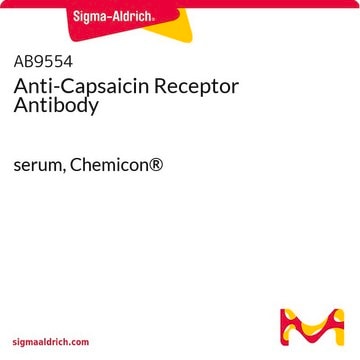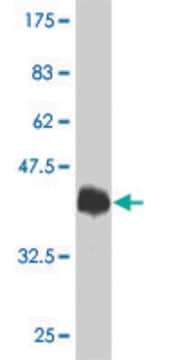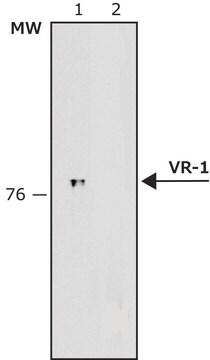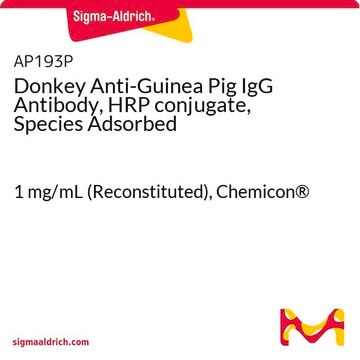AB5889
Anti-Capsaicin Receptor Antibody, NT
serum, Chemicon®
Synonym(s):
Vanilloid Receptor 1, VR1
Sign Into View Organizational & Contract Pricing
All Photos(1)
About This Item
UNSPSC Code:
12352203
eCl@ss:
32160702
NACRES:
NA.41
Recommended Products
biological source
rabbit
Quality Level
antibody form
serum
antibody product type
primary antibodies
clone
polyclonal
species reactivity
primate, mouse, rat
manufacturer/tradename
Chemicon®
technique(s)
immunohistochemistry: suitable
western blot: suitable
NCBI accession no.
UniProt accession no.
shipped in
dry ice
target post-translational modification
unmodified
Gene Information
human ... TRPV1(7442)
Specificity
Capsaicin Receptor (VR1), N-terminal.
SPECIES REACTIVITIES:
Rat, mouse and primate. Other species have not been tested.
SPECIES REACTIVITIES:
Rat, mouse and primate. Other species have not been tested.
Immunogen
Epitope: N-terminus
Synthetic peptide corresponding to the N-terminus of rat VR1.
Application
Immunoblotting: 1:1,000
Immunohistochemistry: 1:1,000
Optimal working dilutions must be determined by the end user.
APPLICATION NOTES FOR AB5889
IMMUNOHISTOCHEMISTRY
Male Sprague-Dawley rats (b.wt. 100-150g) were anesthetized with sodium pentobarbital and perfused via the ascending aorta with: 1) 50 mL of Ca2+-free Tyrode+s solution followed by 2) fixative, and 3) 10% sucrose in PBS as a cryo-protectant. Tissues were rapidly dissected out and stored overnight in 0.1 M phosphate buffer (pH 7.4) containing 10% sucrose.
Slide-mounted tissue sections were incubated with blocking buffer for 1 hour at room temperature. Primary antibody was diluted in blocking buffer to the appropriate working dilution. Blocking buffer was removed and the slides were then incubated at 2-8°C for 18-24 hours with AB5889. After rinsing in PBS 3 times sections were incubated for 60 minutes at room temperature with Cy3-conjugated secondary antibodies. After mounting in a mixture of PBS and glycerol (1:3) containing 0.1% p-phenylenediamine, sections were examined with a Nikon Microphot-SA epifluorescence microscope.
IMMUNOHISTOCHEMISTRY
VR1 transfected cells were processed for indirect immunofluorescence. Media was removed and cells were gently washed 3 times with serum-free media. Following fixation procedure, cells were processed for indirect immunofluorescence as described above.
WESTERN BLOT
For details see Guo, A., et al., Eur J Neurosci (1999) 11:946-958.
Immunohistochemistry: 1:1,000
Optimal working dilutions must be determined by the end user.
APPLICATION NOTES FOR AB5889
IMMUNOHISTOCHEMISTRY
Male Sprague-Dawley rats (b.wt. 100-150g) were anesthetized with sodium pentobarbital and perfused via the ascending aorta with: 1) 50 mL of Ca2+-free Tyrode+s solution followed by 2) fixative, and 3) 10% sucrose in PBS as a cryo-protectant. Tissues were rapidly dissected out and stored overnight in 0.1 M phosphate buffer (pH 7.4) containing 10% sucrose.
Slide-mounted tissue sections were incubated with blocking buffer for 1 hour at room temperature. Primary antibody was diluted in blocking buffer to the appropriate working dilution. Blocking buffer was removed and the slides were then incubated at 2-8°C for 18-24 hours with AB5889. After rinsing in PBS 3 times sections were incubated for 60 minutes at room temperature with Cy3-conjugated secondary antibodies. After mounting in a mixture of PBS and glycerol (1:3) containing 0.1% p-phenylenediamine, sections were examined with a Nikon Microphot-SA epifluorescence microscope.
IMMUNOHISTOCHEMISTRY
VR1 transfected cells were processed for indirect immunofluorescence. Media was removed and cells were gently washed 3 times with serum-free media. Following fixation procedure, cells were processed for indirect immunofluorescence as described above.
WESTERN BLOT
For details see Guo, A., et al., Eur J Neurosci (1999) 11:946-958.
Research Category
Neuroscience
Neuroscience
Research Sub Category
Neuroinflammation & Pain
Neurotransmitters & Receptors
Neuroinflammation & Pain
Neurotransmitters & Receptors
This Anti-Capsaicin Receptor Antibody, N-terminus is validated for use in WB, IH for the detection of Capsaicin Receptor.
Physical form
Liquid. Contains 0.05% sodium azide.
Storage and Stability
Maintain at -20°C in undiluted for up to 6 months after date of receipt. Avoid repeated freeze/thaw cycles. Do not store in a self-defrosting freezer.
Legal Information
CHEMICON is a registered trademark of Merck KGaA, Darmstadt, Germany
Disclaimer
Unless otherwise stated in our catalog or other company documentation accompanying the product(s), our products are intended for research use only and are not to be used for any other purpose, which includes but is not limited to, unauthorized commercial uses, in vitro diagnostic uses, ex vivo or in vivo therapeutic uses or any type of consumption or application to humans or animals.
Not finding the right product?
Try our Product Selector Tool.
Storage Class Code
10 - Combustible liquids
WGK
WGK 1
Certificates of Analysis (COA)
Search for Certificates of Analysis (COA) by entering the products Lot/Batch Number. Lot and Batch Numbers can be found on a product’s label following the words ‘Lot’ or ‘Batch’.
Already Own This Product?
Find documentation for the products that you have recently purchased in the Document Library.
Min Jee Kim et al.
Molecular pain, 14, 1744806918814345-1744806918814345 (2018-11-02)
The insular cortex is an important region of brain involved in the processing of pain and emotion. Recent studies indicate that lesions in the insular cortex induce pain asymbolia and reverse neuropathic pain. Endogenous cannabinoids (endocannabinoids), which have been shown
Dekel Rosenfeld et al.
Science advances, 6(15), eaaz3734-eaaz3734 (2020-04-18)
The field of bioelectronic medicines seeks to modulate electrical signaling within peripheral organs, providing temporally precise control of physiological functions. This is usually accomplished with implantable devices, which are often unsuitable for interfacing with soft and highly vascularized organs. Here
Our team of scientists has experience in all areas of research including Life Science, Material Science, Chemical Synthesis, Chromatography, Analytical and many others.
Contact Technical Service








